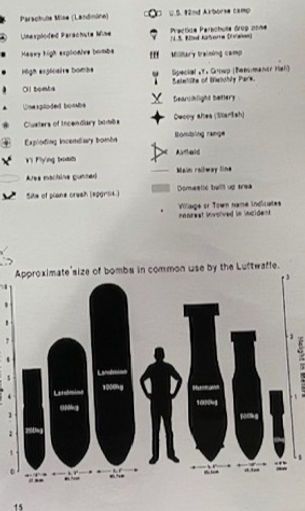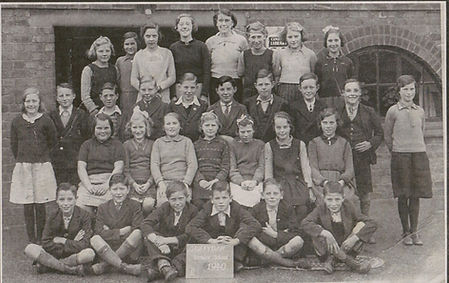
War Years

War Heroes
Samuel Bartholomew Albert Smith

Samuel Bartholomew Albert Smith was born in Main Street Osgathorpe c.1920, to Samuel and Selina Smith. He was a former Coalville Broom Leys School boy and joined the Guards at the outbreak of the Second World War. Samuel was one of the many rescued from the beaches of Dunkirk when they were under attack from the Germans.
Going by the June 3rd 1940 date stamp on the following letter, Samuel Smith would have been one of the first batches of servicemen evacuated from the beaches of Dunkirk. The letter was sent to his then girlfriend Beryl at the age of 20 from Somme Barracks, Sheffield, after he had arrived back in England. In the letter he describes having to swim in his clothes to the boat that picked him up. Over 1,000 British servicemen died during the evacuation.


Guardsman Samuel Smith, without cap, thought to have been taken at Somme Barracks, Sheffield following the Dunkirk evacuation.
Whilst still in the Guards, he married his girlfriend Miss Beryl Eileen Smith of Main Street Osgathorpe. Having studied Samuel's cap, coloured band, and badge together with his uniform, it suggests he was a member of the Royal Scots Guards, although no official record has been located.


LEFT TO RIGHT
BACK ROW : Gwen Smith; Lena and Sam Smith (Sam's parents); ? ; ? ; Samuel Smith ; Eric Siddons ; Hilda Siddons ; "Granny" Elliot ; Freda King FRONT ROW : ? ; Beryl Smith (nee Siddons) ; Freda Smith ; Edna Green
It is not known exactly when Sergeant Samuel Smith (657263) of 602 Squadron transferred to the R.A.F from the Guards as a spitfire pilot, but it is unlikely it would have been prior to the 12th August 1940 when the original 602 City of Glasgow Auxiliary Squadron was re-sited to Westhanpnett Airbase near Chichester, Sussex on the south coast to replace the 145 Squadron. This was right in the front line of action in the Battle of Britain. The Westhanpnett airbase which was shared with the Americans was opened in 1938 and closed in 1946. Sergeant Samuel Smith could have spent a period here before he was subsequently stationed at R.A.F Perranporth which became operational on 28th of April 1941, and where 602 Squadron Royal Auxiliary Air Force which he was with was also stationed. The airfield was used by 21 different squadrons flying Spitfires, and was decommissioned in April 1946.


Samuel Smith in his Spitfire flying gear taken at Perranporth R.A.F. Station
Samuel was a fighter pilot in the Dieppe Raids which he survived. It was whilst stationed at R.A.F. Perranporth on January 23rd 1943, that Sergeant Samuel Smith tragically lost his life in a flying accident. The accident was reported as follows:
On the 23rd of January 1943 at 1541hrs., two Super marine Spitfire Mark Vc aircraft EE682 and EE633 of 602 Squadron Royal Auxiliary Air Force RAF Perranporth collided in mid-air. EE682 crashed into the sea off Prussia Cove, 2 miles S.S.E. of Goldsithney Police House. The aircraft sank and the body of the pilot Sgt Samuel Smith 657263 was recovered from the sea. EE633 managed to land safely at Perranporth.
A copy of the letter sent to Sam's wife Beryl by the Squadron Leader, Commanding No. 602 Squadron, R.A.F. the day after she received the telegram informing her of his death.


Memorial Plaque In St. Mary's Church, Osagathorpe

Perranporth War Memorial Hall - Sgt Smith is listed under 602 Squadron


Commonwealth War Graves Commission Gravestone In Osgathorpe New Cemetery

Commonwealth War Graves Commission Certificate
Extracts Taken From Samuel T Stewart's Publication With His Kind Permission
BOMBINGS IN THE LOCAL AREA
The Map indicates areas covered by bombs during World War II and shows clusters of incendiary bombs close to Osgathorpe


Evacuees
The evacuation of Britain’s cities at the start of World War Two was the largest movement of people in Britain’s history. In four days during early September 1939, nearly three million people were transported from towns and cities to places of safety in the countryside. From 1939 until 1944, children from Birmingham, Coventry and London were evacuated to this area and local school logs record approximately 30% of the 75 evacuees were hosted in Osgathorpe.

A SYNOPSIS OF A LARGER REPORT IN THE LEICESTER DAILY MERCURY DATED SEPTEMBER 1ST 1939
Carrying their gas masks and satchels, thousands of child evacuees arrived by special trains at twelve Leicestershire railway stations just prior to Germany invading Poland on September 1st 1939.
A large crowd assembled at the L.M.S. railway station at Coalville, to see the arrival of the special trains carrying evacuees from Birmingham. The Chairman, Mr. S. E. Perry, and members of the Urban Council, Dr. Andrew Hamilton (Medical Officer) and officials of the council were on the platform.
The first train brought 341 evacuees, boys and girls belonging to the Dennis Road School, Birmingham. The children were smiling as they stepped out of the train and seemed quite happy and contented.
All the traffic was stopped as they were taken across High Street to the Constitutional Club., where they received rations. They were then taken to the central field where they were grouped ready for transport to the various schools. They were taken by bus to outlying areas.
On arrival at the schools, the various headmasters took charge and the children were taken to their new homes to be received by their hosts. One of the Birmingham teachers told the Leicester Mercury ‘that they had a very comfortable journey, and it rained heavily as they left Birmingham and they were glad to see the sun shining at Coalville’. ‘You have given us a Royal welcome’ said another teacher.
This morning, 500 secondary school children arrived at Ashby from Birmingham and were escorted to schools in the town. After a medical inspection and refreshments at the town hall, they were sent to their respective billets (hosts homes). Other batches will follow tomorrow. Mr. C. B. Dearden is the billeting officer.
Several hundred children arrived this afternoon, also from Birmingham for the rural areas. They were escorted by Mr. W. Smith to the Burton Road Council Schools, and there handed a 48 hour ration comprising biscuits, tinned milk, chocolate etc.
Mr. W. A. Brockington (Director of Education) who is touring the county said ‘that local arrangements were admirable’.
More children arrive tomorrow and the total for the rural area is estimated at 1,040. The allocations to date are:-
Griffydam
Worthington
Heather
Newton Donnisthorpe
Oakthorpe
Coleorton
Staunton
Osgathorpe
Swannington
Packington
Measham
Appleby
140
60
50
30
120
80
40
20
25
100
30
200
70

The 1939 register records that Osgathorpe's Rector, the Rev. Cyril William James Perry was the Air Raid Warden and that his wife was the “Parish Billeting Officer” for Osgathorpe which involved organising the hosts for the evacuees. The 1940 Griffydam Senior School photograph shows on the third row, two boys on the extreme right next to the girl. They were evacuees Gerald and Harold Latham who stayed at Manor House Farm.
Evacuees hosted in Osgathorpe (24 identified on the Griffydam School Registers)